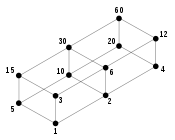| This article needs additional citations for verification. Please help improve this article by adding citations to reliable sources. Unsourced material may be challenged and removed. Find sources: "Unusual number" – news · newspapers · books · scholar · JSTOR (May 2015) (Learn how and when to remove this message) |

In number theory, an unusual number is a natural number n whose largest prime factor is strictly greater than .
A k-smooth number has all its prime factors less than or equal to k, therefore, an unusual number is non--smooth.
Relation to prime numbers
All prime numbers are unusual. For any prime p, its multiples less than p are unusual, that is p, ... (p-1)p, which have a density 1/p in the interval (p, p).
Examples
The first few unusual numbers are
- 2, 3, 5, 6, 7, 10, 11, 13, 14, 15, 17, 19, 20, 21, 22, 23, 26, 28, 29, 31, 33, 34, 35, 37, 38, 39, 41, 42, 43, 44, 46, 47, 51, 52, 53, 55, 57, 58, 59, 61, 62, 65, 66, 67, ... (sequence A064052 in the OEIS)
The first few non-prime (composite) unusual numbers are
- 6, 10, 14, 15, 20, 21, 22, 26, 28, 33, 34, 35, 38, 39, 42, 44, 46, 51, 52, 55, 57, 58, 62, 65, 66, 68, 69, 74, 76, 77, 78, 82, 85, 86, 87, 88, 91, 92, 93, 94, 95, 99, 102, ... (sequence A063763 in the OEIS)
Distribution
If we denote the number of unusual numbers less than or equal to n by u(n) then u(n) behaves as follows:
| n | u(n) | u(n) / n |
| 10 | 6 | 0.6 |
| 100 | 67 | 0.67 |
| 1000 | 715 | 0.72 |
| 10000 | 7319 | 0.73 |
| 100000 | 73322 | 0.73 |
| 1000000 | 731660 | 0.73 |
| 10000000 | 7280266 | 0.73 |
| 100000000 | 72467077 | 0.72 |
| 1000000000 | 721578596 | 0.72 |
Richard Schroeppel stated in the HAKMEM (1972), Item #29 that the asymptotic probability that a randomly chosen number is unusual is ln(2). In other words:
References
- Schroeppel, Richard (April 1995) . Baker, Henry Givens Jr. (ed.). "ITEM 29". HAKMEM (retyped & converted ed.). Cambridge, Massachusetts, USA: Artificial Intelligence Laboratory, Massachusetts Institute of Technology (MIT). AI Memo 239 Item 29. Archived from the original on 2024-02-24. Retrieved 2024-06-16.
External links
| Divisibility-based sets of integers | ||
|---|---|---|
| Overview |  | |
| Factorization forms | ||
| Constrained divisor sums | ||
| With many divisors | ||
| Aliquot sequence-related | ||
| Base-dependent | ||
| Other sets | ||

